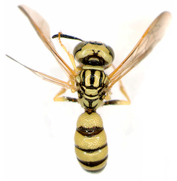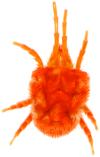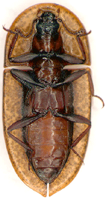Screening arthropod DNA samples for Wolbachia
Testing for the presence of Wolbachia is a simple PCR based process. The necessary steps are: 1) Collection and preservation of insects or other arthropods. 2) DNA extraction from arthropods. 3) PCR test for the detection of Wolbachia genes as well as arthropod control genes. An optional additional step is to sequence one of more Wolbachia genes to determine phylogenetic relationship to other known Wolbachia strains.
Step 1: Collection and Preservation of Insects
There are many easy methods for collecting insects, with sweep netting being among the easiest. After insects are collected, it is essential that they are preserved properly so that DNA is not degraded before step #2. Failure to properly preserve and store insect samples may result in false negative results in step 3. One of the simplest methods of preserving insects and their DNA is to store insects immediately in cold ethanol (95-100%). Ideally, insects should be put into ethanol immediately upon collection. Samples should be stored as soon as possible in a freezer. Samples should be stored in several volumes of ethanol relative to insect volume (if you have 50 ml of insects, you should use 150-200 ml ethanol). The DNA from insects stored in ethanol at -20C remains intact for months or years.
Step 2: DNA Extraction
There are many different methods available for extracting DNA from insects and Wolbachia. We recommend a column based DNA extraction kit. They are relatively easy to use and result in high quality DNA. The basic procedure is as follows: samples are ground up in a buffer that will aid in the lysis of cells and digestion of proteins. The resulting mixture is then put through a column to which DNA will bind and all other cellular material can be washed away. Finally, the DNA is unbound from the column and collected. For more detailed information, see DNA EXTRACTION PROTOCOL.
Step 3: PCR Detection of Wolbachia Genes
PCR is the exponential amplification of specific pieces of DNA. The PCR test for Wolbachia works by amplifying a piece of Wolbachia DNA only when Wolbachia is present in an insect. As a control, a separate piece of insect DNA is also amplified from each sample tested. The specificity of PCR relies on primers (small segments of DNA) which recognize and bind to only very specific segments of DNA. Failure of primers to bind to a piece of DNA will result in no amplification. The primers used in this test are 2 which recognize and bind to only a short portion of Wolbachia DNA from the 16S ribosomal gene and 2 primers (controls) which recognize and bind to a portion of mitochondrial DNA found in any arthropod. Once PCR has been performed, agarose gel electrophoresis is used to visualized both amplified host insect and Wolbachia DNA (when present) and determine infection status. For more information, see PCR PROTOCOL and AGAROSE GEL ELECTROPHORESIS PROTOCOL.
Step 4 (Optional):
Once a an insect has been determined to have been infected with Wolbachia, we can ask which type of Wolbachia strain or strains infected that insect. This can be determined by sequencing the piece of Wolbachia DNA amplified in Step 3. By comparing the DNA sequence of the newly discovered Wolbachia strain,








